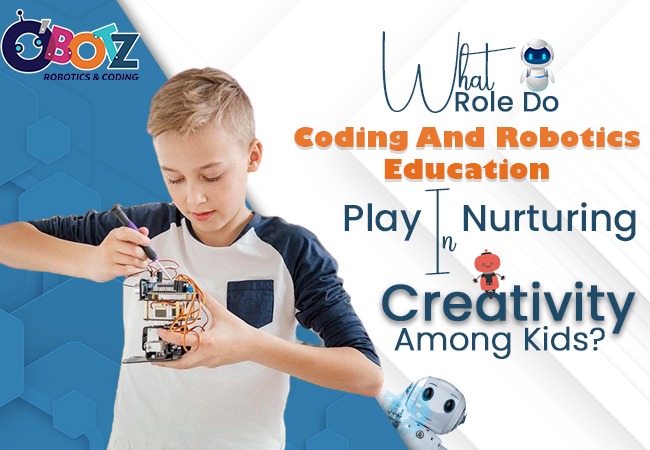What Role Do Coding And Robotics Education Play In Nurturing Creativity Among Kids?
The learning paradigm has undergone extreme changes, and children’s education is now more centered on getting them ready with 21st-century skills. The two, that are gaining prominence in this context, are Robotics Education and coding as tools for fostering creativity and critical thinking in children. Introducing children to coding and robotics not only prepares them for the future but also ignites their curiosity, allowing them to explore, experiment, and innovate. Let’s have a look at how such modern teaching tools hold an important place in fostering creativity in young minds.
1. Development of Imaginative Problem-Solving Skills
The first benefit of Robotics Education is the development of imaginative problem-solving skills among children. With robotics projects, expectation can include their ability to build some robots or program other robots to perform a given function. The process is certainly going to call for critical thinking, unique solutions, and possibly experimentation in an approach. For example, if a robot does not move as expected, kids have to troubleshoot this problem, modify the code, or even redesign the robot. Through this practical nature of the activity, creativity is enhanced because they can view things from different angles and come up with original solutions.
The children working on robotics projects start viewing problems as opportunities rather than obstacles. In this sense, this method enhances their ability to think outside of the box and put creative thinking to work in real-life circumstances.
Click here for Read this blog: Why Every School Should Offer Robotics Programs for Kids
The children working on robotics projects start viewing problems as opportunities rather than obstacles. In this sense, this method enhances their ability to think outside of the box and put creative thinking to work in real-life circumstances.
Click here for Read this blog: Why Every School Should Offer Robotics Programs for Kids

2. Eliciting Imagination through Coding Projects
Another feature of modern education is coding, which deeply contributes to the creative personality of a child. Creating something on their own in digital form according to their imagination makes children learn how to code. For instance, they can make animations, games, or even an app.
While learning to code, the children get the power to convert their abstract concepts into actual projects. Such a process means the sense of creativity with which it’s practiced provides a free hand to design or build whatever can be thought of. Seeing their project come to life further motivates them to be creative thinkers and learn new challenges to overcome.
While learning to code, the children get the power to convert their abstract concepts into actual projects. Such a process means the sense of creativity with which it’s practiced provides a free hand to design or build whatever can be thought of. Seeing their project come to life further motivates them to be creative thinkers and learn new challenges to overcome.
3. Equipment and Technology Costs
Robotics for Kids is an engaging manner of teaching mainly STEM subjects practically and playfully. Indeed, unlike traditional classroom learning, where children passively absorb information, in robotics education, the thrust is on a more actively engaged learning situation. The active learning style is, therefore very essential because it will stimulate creativity by allowing kids to experiment, discover, and learn through trial and error.
For instance, to assemble a robot, diverse scientific knowledge from fields like physics, engineering, and computer science needs to be utilized. The kids have to creatively combine different components such as sensors and motors so that the robot functions well. During the process, the kids learn technical skills creative thinking, and application of knowledge in innovative ways.
For instance, to assemble a robot, diverse scientific knowledge from fields like physics, engineering, and computer science needs to be utilized. The kids have to creatively combine different components such as sensors and motors so that the robot functions well. During the process, the kids learn technical skills creative thinking, and application of knowledge in innovative ways.
4. Operation Costs and Overheads
Robotics and coding projects are usually done in a group environment, where children strive to achieve the same goals. This group environment is very conducive to creativity because kids can communicate various ideas, share the perspectives of other people, and learn from one another. Being cognizant of diverse thinking styles and problem-solving methods may inspire kids to think creatively when working together.
For example, while doing a group project on designing a robot, one child may be great at coding, another at designing the robot’s physical structure, and a third at troubleshooting. By pooling and sharing their unique skills, the team would come up with a far more creative and effective solution than they could have managed individually. The process teaches kids the value of teamwork and the creative power of thinking in collective groups.
Click here for Read this blog: How Can Robotics Education Contribute To A Child’s Creativity And Imagination?
For example, while doing a group project on designing a robot, one child may be great at coding, another at designing the robot’s physical structure, and a third at troubleshooting. By pooling and sharing their unique skills, the team would come up with a far more creative and effective solution than they could have managed individually. The process teaches kids the value of teamwork and the creative power of thinking in collective groups.
Click here for Read this blog: How Can Robotics Education Contribute To A Child’s Creativity And Imagination?
5. Increase Confidence and Growth Mindset
A few of the less apparent but very important benefits of Robotics Education are increases in the self-confidence of children and the development of a growth mindset. Whenever kids are given such tools and can either build their robots or create their programs, they begin to feel a sense of control and accomplishment that further boosts their self-esteem and encourages them to take up even more challenging tasks in the future.
It places heavy emphasis on perseverance and learning from failure. In robotics as well as in coding, bugs and errors will always be there. The difference is this: while it may be your failure or a shortcoming at a particular task, kids have learned to interpret those setbacks as opportunities to learn and get better. The great mentality shift empowers children to be adaptable and makes them resilient two huge parts of any inventive and innovative mindset.
Click here for Read this blog: Robotics for Kids: A Step-by-Step Guide to Building the Future
It places heavy emphasis on perseverance and learning from failure. In robotics as well as in coding, bugs and errors will always be there. The difference is this: while it may be your failure or a shortcoming at a particular task, kids have learned to interpret those setbacks as opportunities to learn and get better. The great mentality shift empowers children to be adaptable and makes them resilient two huge parts of any inventive and innovative mindset.
Click here for Read this blog: Robotics for Kids: A Step-by-Step Guide to Building the Future
6. Preparing the Future Worker
Coding and robotics capabilities will be of monumental value in a world becoming more digitized and automated. Robotics for Kids will introduce creativity at an early age, while preparing them for great careers shortly. Technology, engineering, and design careers require high-grade creativity and problem-solving, all encouraged in robotics and coding education.
Another benefit of robotics and coding is the potential to transfer skills to various activities. Logical thinking, project management, and innovative problem-solving are skills that could be applied in several other industries. Regardless of a child’s career choice in technology or any other field, the creative ability they imbibe with coding and robotics will help them all their lives.
Another benefit of robotics and coding is the potential to transfer skills to various activities. Logical thinking, project management, and innovative problem-solving are skills that could be applied in several other industries. Regardless of a child’s career choice in technology or any other field, the creative ability they imbibe with coding and robotics will help them all their lives.
Conclusion: How India Should View Robotics Education End
In all, the role of coding and Robotics Education in fostering creativity among children cannot be understated. Here we provide youngsters with the possibility to build, code, and create tools and knowledge. This helps them develop creative thinking and problem-solving skills. Robotics for Kids is a concept in modern education that helps bring together the theoretical know-how and practical know-how closer to making learning interactive and efficient.
With growing interest in technology and innovation, Robotics Education in India is picking up pace. Schools and other education-based initiatives are slowly realizing that they need to educate the children about tomorrow’s skills. With these educational tools, we are not only developing a generation of creative thinkers but also going to be prepared innovators and problem solvers of the future.
With growing interest in technology and innovation, Robotics Education in India is picking up pace. Schools and other education-based initiatives are slowly realizing that they need to educate the children about tomorrow’s skills. With these educational tools, we are not only developing a generation of creative thinkers but also going to be prepared innovators and problem solvers of the future.



